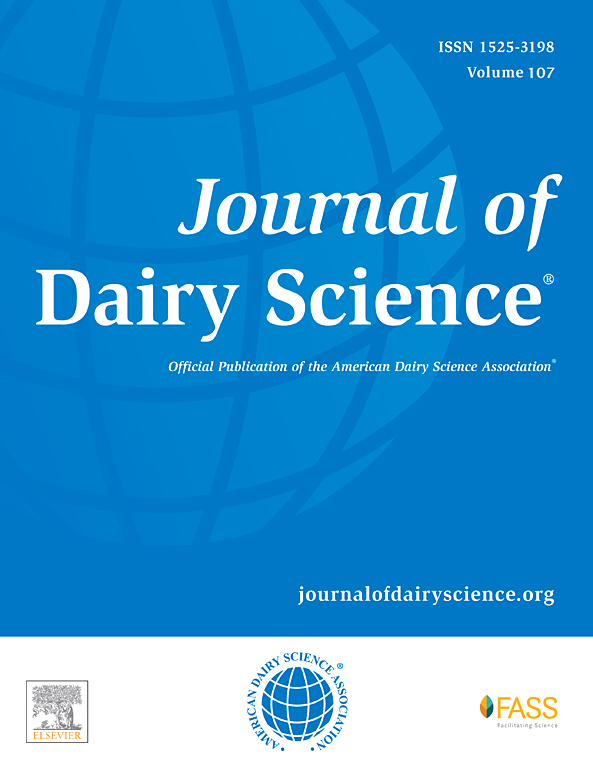A randomized controlled trial evaluating the effect of providing a rest period during long-distance transportation of surplus dairy calves: Part I. Effect on health, growth, and activity
IF 3.7
1区 农林科学
Q1 AGRICULTURE, DAIRY & ANIMAL SCIENCE
引用次数: 0
Abstract
The objective of this randomized controlled trial was to determine whether providing a rest period to surplus calves transported for 16 h reduced the effect of long-distance transportation on health, growth, and activity after arrival to a calf-raising facility. Between September 2022 to January 2023, 6- to 24-d-old surplus calves were randomly assigned to one of 2 treatment groups: (1) continuous transportation by road for 16 h (n = 86) or (2) 8 h of transport, an 8 h rest period, then a further 8 h of transport to a single commercial calf-raising facility in Ontario, Canada (n = 84). Calves that received the rest period were fed 2 L of milk replacer at the time of unloading for the rest period and again before reloading for the second leg of transportation. Calves were weighed before and after transportation and once weekly until they left the calf-raising facility at 11 wk after arrival. Additionally, fecal consistency and respiratory health were assessed immediately before and after transportation, as well as twice daily following arrival. The odds of abnormal fecal and respiratory scores were assessed with mixed effects logistic regression models, whereas Cox proportional hazards models were used to evaluate the hazard of treatment for diarrhea and respiratory disease. To evaluate weight loss during transportation, ADG, lying bouts, and steps, mixed linear regression models were used. Furthermore, mixed logistic regression models with repeated measures were built to assess associations with the odds of having a sunken flank and prolonged skin tent. There were no statistical differences in the odds of abnormal fecal or respiratory scores or the treatment for diarrhea between treatment groups; however, there was evidence that calves that received a rest period had a higher hazard of treatment for respiratory disease. Calves >10 d old had reduced odds of having an abnormal respiratory score and calves 13 to 24 d old had lower odds of arriving with a prolonged skin tent, lower odds of abnormal fecal score, and reduced hazard of treatment for diarrhea compared with calves that were 6 to 8 d old at transportation. During transportation, calves that received a rest period lost less weight than continuously transported calves. With respect to ADG over the 77-d study, an interaction between age at transport and treatment group was identified where calves aged 9 to 10 d old and receiving a rest period had higher ADG compared with calves that were 9 to 10 d old and not receiving a rest period. As for calf activity, calves receiving an rest period spent more time lying on the day after transportation compared with calves that were continuously transported. The results of this trial show few differences in the health and growth of calves having a rest period compared with those that underwent continuous transport. Furthermore, calves receiving a rest period may arrive more fatigued than calves that arrive at their destination in a shorter period of time overall. Transporting calves at older ages presents an opportunity to reduce the effect of long-distance transportation on subsequent health, growth, and activity.
一项随机对照试验,评估在长途运输剩余奶牛犊牛期间提供休息时间的效果:第一部分:对健康、生长和活动的影响。
本随机对照试验的目的是确定为运输 16 小时的剩余犊牛提供休息期(RP)是否会减少长途运输对犊牛到达饲养场后的健康、生长和活动的影响。在 2022 年 9 月至 2023 年 1 月期间,6 至 24 日龄的剩余犊牛被随机分配到两个处理组中的一个:1)连续公路运输 16 小时(n = 86)或 2)运输 8 小时,休息 8 小时,然后再运输 8 小时到加拿大安大略省的一个商业犊牛饲养场(n = 84)。在卸载犊牛进行 RP 时,给接受 RP 的犊牛喂食 2 升代乳粉,并在重新装载犊牛进行第二段运输之前再次喂食代乳粉。犊牛在运输前后称重,每周称重一次,直到抵达 11 周后离开犊牛饲养场。此外,在运输前后以及到达后每天两次对犊牛的粪便浓度和呼吸健康状况进行评估。采用混合效应逻辑回归模型评估粪便和呼吸系统评分异常的几率,而采用 cox 比例危险模型评估腹泻和呼吸系统疾病治疗的危险性。在评估运输过程中的体重减轻、平均日增重、卧位和步数时,采用了混合线性回归模型。此外,还建立了重复测量的混合逻辑回归模型,以评估腹部凹陷和皮肤帐篷时间过长的几率。不同治疗组的犊牛在粪便或呼吸评分异常几率或腹泻治疗方面没有统计学差异;但有证据表明,接受休息期治疗的犊牛患呼吸道疾病的几率更高。与运输时 6-8 日龄的犊牛相比,10 日龄以上的犊牛呼吸道评分异常的几率降低,13-24 日龄的犊牛皮肤帐篷时间延长的几率降低,粪便评分异常的几率降低,腹泻治疗的危险性降低。在运输过程中,获得休息期的犊牛比连续运输的犊牛体重减轻。在 77 天的研究中,运输日龄与处理组之间存在交互作用,与 9 至 10 天大且未接受休息的犊牛相比,9 至 10 天大且接受休息的犊牛的 ADG 较高。至于犊牛的活动量,与连续运输的犊牛相比,接受休息期的犊牛在运输次日躺卧的时间更长。试验结果表明,与连续运输的犊牛相比,接受 "可逆饲养 "的犊牛在健康和生长方面几乎没有差异。此外,与在较短时间内到达目的地的犊牛相比,接受休息期的犊牛可能会更加疲劳。较大年龄的犊牛运输为减少长途运输对后续健康、生长和活动的影响提供了机会。
本文章由计算机程序翻译,如有差异,请以英文原文为准。
求助全文
约1分钟内获得全文
求助全文
来源期刊

Journal of Dairy Science
农林科学-奶制品与动物科学
CiteScore
7.90
自引率
17.10%
发文量
784
审稿时长
4.2 months
期刊介绍:
The official journal of the American Dairy Science Association®, Journal of Dairy Science® (JDS) is the leading peer-reviewed general dairy research journal in the world. JDS readers represent education, industry, and government agencies in more than 70 countries with interests in biochemistry, breeding, economics, engineering, environment, food science, genetics, microbiology, nutrition, pathology, physiology, processing, public health, quality assurance, and sanitation.
 求助内容:
求助内容: 应助结果提醒方式:
应助结果提醒方式:


